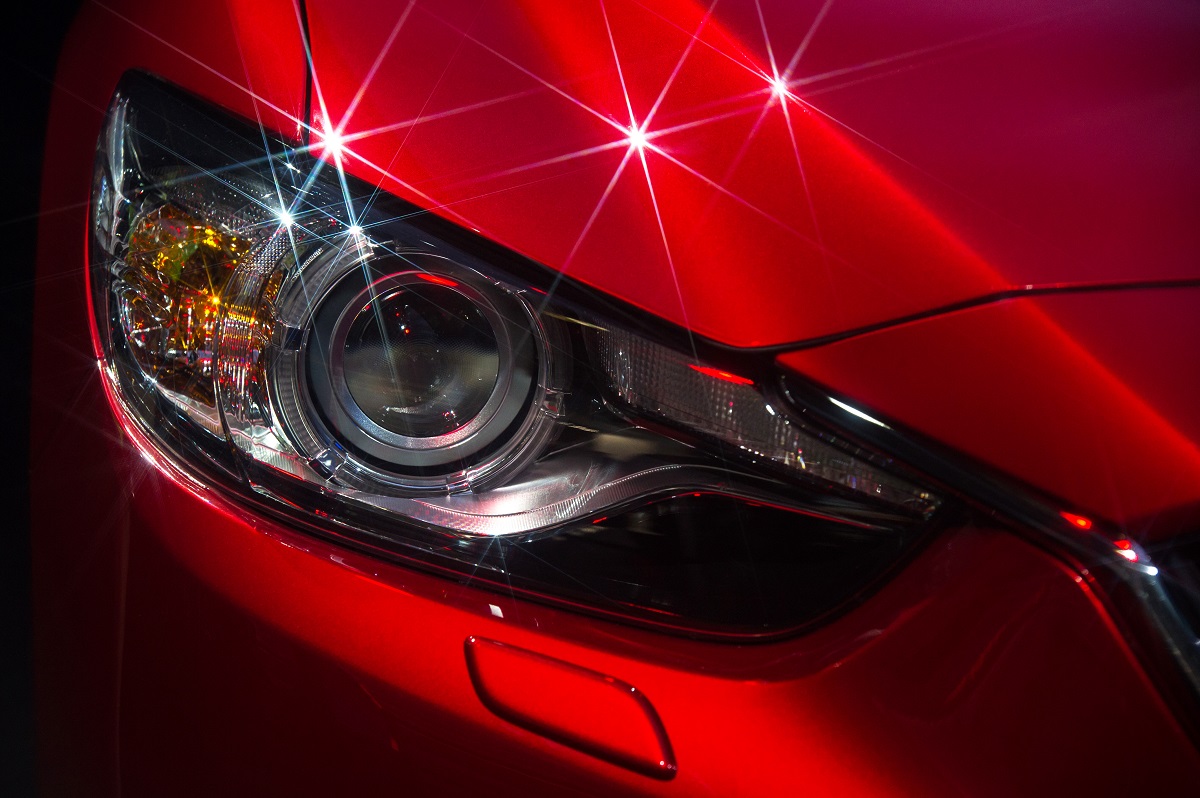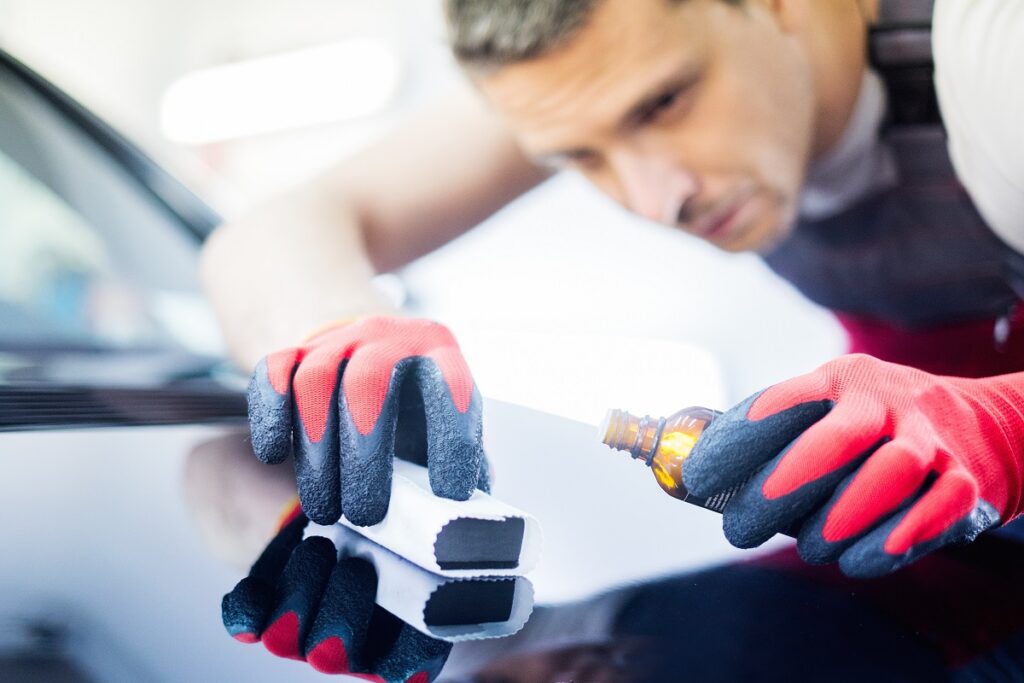Maintaining your vehicle goes beyond its engine and interior; the exterior is equally crucial. With the global automotive coatings market surpassing $21 billion in 2019, it’s clear that car enthusiasts are increasingly recognizing the significance of protective measures.
This article will delve into everything you need to know about ceramic coating for cars, an innovative solution revolutionizing the world of automotive care. From enhanced durability to a stunning, showroom-quality finish, explore the benefits and application of ceramic coatings, ensuring your vehicle remains pristine for years.
What is Ceramic Coating?
Ceramic coating, also known as nano-ceramic coating or ceramic paint coating, is an advanced protective layer applied to a vehicle’s exterior surfaces. It has gained immense popularity among car enthusiasts and owners for its remarkable ability to provide long-lasting protection and enhance the appearance of their vehicles.
Unlike traditional car wax or sealant, ceramic coating provides superior protection that can last up to five years. Formulated with ceramic particles, these coatings act as a permanent bond on the vehicle’s surface and provide a hard layer of protection.
How Does Ceramic Coating Work?
Ceramic coating, at its essence, is a liquid polymer infused with nanoparticles of silicon dioxide (SiO2) or titanium dioxide (TiO2). It boasts a unique composition that enhances word choice, structure, readability, and eloquence while staying true to its original purpose. These nanoparticles are incredibly small, often on the nanometer scale, which means they’re measured in billionths of a meter. When applied to a car’s paint surface, these nanoparticles undergo a fascinating chemical transformation.
The key to ceramic coating’s efficacy is the process of cross-linking. As the liquid coating is applied, the nanoparticles bond with the molecules in the vehicle’s paint. This bond is typically covalent or molecular, forming a robust and permanent connection.
This chemical bond creates an ultra-thin, transparent, and durable layer on top of the paint. This layer is exceptionally smooth and hydrophobic, repelling water and other liquids. It also forms a strong barrier against environmental contaminants and UV radiation.
The hydrophobic property occurs because the nanoparticles create an incredibly smooth surface on a microscopic level. This smoothness causes water to bead up and roll off, taking contaminants like dirt, grime, and pollutants with it. As a result, the car’s surface remains cleaner, and it’s easier to wash.
The strength of this bond also gives ceramic coatings their scratch resistance. While not impervious to scratches, they can withstand minor abrasions better than unprotected paint.
Is Ceramic Coating Worth the Investment?
Investing in a ceramic coating for your car is a decision that depends on your priorities and expectations as a vehicle owner. While it comes at a cost, many enthusiasts and meticulous car owners consider it a worthwhile investment. It’s essential to delve into the advantages of ceramic coating to help you decide whether it’s worth it
Advantages of Ceramic Coating for Car Paint Protection
You can reap various significant benefits by investing in ceramic coating for your vehicle. The most notable advantages include:
Long-lasting Protection Against UV Rays and Oxidation
One of the primary reasons car owners opt for ceramic coating is its ability to provide long-term protection against UV rays and oxidation. The ceramic layer acts as a barrier, preventing harmful UV rays from reaching your car’s paint. UV exposure can lead to paint fading, discoloration, and oxidation, which can diminish your vehicle’s appearance and value. With a ceramic coating, your car’s paint stays vibrant and retains its original luster for an extended period, making it look newer for longer.
Enhanced Resistance to Scratches and Swirl Marks

Another significant advantage of ceramic coatings is their ability to resist scratches and swirl marks. While they won’t make your car completely impervious to damage, they offer protection against minor abrasions and scratches from day-to-day use. This means your vehicle’s finish remains smoother and free from unsightly imperfections, contributing to a pristine appearance.
Easy Maintenance and Cleaning
Ceramic-coated cars are notably easier to clean and maintain. The hydrophobic properties of the coating make it difficult for dirt, dust, and contaminants to adhere to the surface. When it does come time to clean your vehicle, you’ll find that washing is quicker and requires less effort. Additionally, the coating reduces the frequency of waxing or reapplication compared to traditional waxes and sealants, saving you both time and money in the long run.
Disadvantages of Ceramic Coating
While ceramic coating offers numerous benefits for protecting and enhancing your vehicle’s appearance, it’s essential to consider its disadvantages and limitations before deciding whether it’s the right choice. Here are some of the critical drawbacks associated with ceramic coatings:
Cost
Ceramic coating can be relatively expensive compared to traditional waxing and sealant options. Professional application by certified installers often involves labor costs, making it even pricier. Additionally, high-quality ceramic coating products can have a significant price tag. For some car owners, the cost may outweigh the benefits, particularly if they have budget constraints.
Professional Application
While there are DIY ceramic coating kits available, achieving optimal results typically requires professional installation. A skilled technician can ensure the coating is applied correctly, achieving the desired level of protection and aesthetics. This necessitates an additional cost and may not be accessible to everyone.
Time-Consuming Application
Ceramic coating application is a meticulous process that involves thorough cleaning, surface preparation, and multiple layers of coating. It can take several hours to complete, which might be inconvenient for those seeking a quick solution to protect their car’s paint.
Not a Miracle Solution
Although ceramic coatings offer excellent protection against minor scratches and contaminants, they are not invincible. They won’t prevent all types of damage, such as deep scratches, dings, or accidents. Car owners should still exercise caution to avoid significant damage.
Durability Variability
The durability of ceramic coatings can vary based on multiple factors, such as the product’s quality, the installer’s expertise, and the vehicle’s usage and maintenance. While certain coatings can endure for several years, others might degrade at a faster rate, requiring reapplication.
Limited Repair Options
If the ceramic coating becomes damaged or deteriorates over time, it can be challenging to repair without professional assistance. Attempting to fix or reapply the coating without the necessary expertise can result in undesirable outcomes.
Does ceramic coating enhance the appearance of your car?
Yes, ceramic coating can significantly enhance the appearance of your car in several ways:
Achieving a Deep Gloss and Shine

Ceramic coatings create a smooth and reflective surface on your vehicle’s paint. This results in a deep gloss and high level of shine that can make your car look like it just rolled out of the showroom. The coating’s ability to reflect light gives the paint a visually striking appearance.
Enhancing Color Vibrancy and Clarity
Ceramic coatings can enhance the vibrancy and clarity of your car’s paint color. By forming a transparent layer over the paint, the coating magnifies the underlying color, making it appear richer and more vivid. This effect can make even older or faded paint look rejuvenated.
Minimizing Water Spots and Stains
Ceramic coatings are hydrophobic, meaning they repel water and liquids effectively. This property minimizes the chances of water spots, stains, and contaminants adhering to the surface. When water beads up and rolls off the car, it leaves behind a clean and spot-free finish, contributing to the car’s overall aesthetic appeal.
What are the different types of ceramic coating?
Ceramic coatings have gained popularity for their exceptional protective properties and visual enhancements, but there are various types available, each with its characteristics and applications:
- Professional-Grade Ceramic Coatings: These are the highest-quality ceramic coatings, typically applied by certified professionals. They often provide the longest-lasting protection, lasting several years, and offer superior resistance to environmental contaminants, UV rays, and scratches. Professional-grade coatings may require a multi-step application process, making them more expensive but delivering outstanding results.
- DIY Ceramic Coating Kits: Designed for at-home application, DIY ceramic coating kits are more accessible to car owners. While they may not offer the same level of durability as professional-grade coatings, they still provide excellent protection and enhanced aesthetics. They are a cost-effective option for those who want to apply ceramic coating themselves.
- Hybrid Ceramic Coatings: Hybrid coatings combine elements of traditional sealants or waxes with ceramic nanoparticles. They are often easier to apply than full-fledged ceramic coatings and can be used as a maintenance product. While they offer good protection and shine, their durability may be shorter than professional-grade options.
- Consumer-Grade Spray-On Coatings: These coatings are user-friendly and can be applied quickly and easily. They provide a modest level of protection against minor contaminants and UV damage but may require more frequent reapplication compared to professional-grade options.
How much does ceramic coating typically cost?
The cost of ceramic coating varies significantly depending on several factors, including the type of coating, the size of the vehicle, the quality of the product, and whether you choose professional installation. Here’s a general cost breakdown:
- Professional-Grade Ceramic Coatings: These can cost anywhere from $800 to $2,500 or more, depending on the size and complexity of the vehicle. The price typically includes the coating product, labor, and preparation.
- DIY Ceramic Coating Kits: DIY kits are more budget-friendly, with prices ranging from $50 to $150 for a single kit. These kits often cover multiple applications, making them a cost-effective choice for at-home enthusiasts.
- Hybrid Ceramic Coatings: Hybrid coatings usually fall in the range of $20 to $60 per bottle, offering a more affordable alternative for regular maintenance and touch-ups.
- Consumer-Grade Spray-On Coatings: These products are the most budget-friendly, with prices ranging from $10 to $30 per bottle. They are suitable for those looking for a low-cost, entry-level solution.
Remember that the overall cost may also include surface preparation, such as paint correction or decontamination, which can add to the total expense. Additionally, professional installation typically comes with a higher upfront cost but ensures optimal results.
Are there any alternatives to ceramic coating that offer similar benefits?
There are several alternatives to ceramic coating that offer similar benefits:
- Traditional Wax and Sealants: Wax and sealants provide a protective layer that enhances shine and provides some protection against contaminants and UV rays. However, they typically don’t last as long as ceramic coatings and require more frequent reapplication.
- Paint Protection Film (PPF): PPF is a clear film applied to the car’s exterior surfaces, offering excellent protection against scratches, rock chips, and UV damage. While it provides a different type of protection, it can be a viable alternative to ceramic coating.
- Synthetic Sealants: These are easier to apply than ceramic coatings and offer decent protection and shine. They are a middle-ground option between traditional wax and ceramic coatings in terms of durability.
- Maintenance Sprays: These products can be applied to a ceramic-coated surface or even uncoated paint to enhance shine and hydrophobic properties. They provide a quick and easy way to maintain the appearance of your vehicle between more extensive protection measures.
Maintaining and Caring for a Ceramic Coated Car

After investing in a ceramic coating for your car, proper maintenance is essential to maximize its longevity and effectiveness. Here are some key tips for maintaining and caring for a ceramic-coated car:
- Regular Washing: Wash your car regularly to remove dirt, dust, and contaminants. Use a pH-balanced car wash shampoo and a soft, microfiber wash mitt to prevent scratching. Avoid using abrasive brushes or sponges.
- Use the Two-Bucket Method: When washing your car, employ the two-bucket method. Fill one bucket with soapy water and the other with clean water. Rinse your wash mitt in the clean water bucket after each pass to minimize the chances of transferring contaminants back onto the car’s surface.
- Avoid Automatic Car Washes: While many automatic car washes are convenient, they often use harsh chemicals and abrasive brushes that can damage the ceramic coating. To maintain the integrity of the coating, it is advisable to choose between hand washing or opting for touchless car washes.
- Drying: After washing, dry your car thoroughly with a clean microfiber drying towel or a high-quality drying aid to prevent water spots. Water spots can etch into the coating if left untreated.
- Regular Inspection: Periodically inspect your car’s paint for any contaminants or bonded particles. If you notice contaminants, consider using a clay bar or a clay alternative to gently remove them.
Can you apply the ceramic coating yourself, or should you seek professional help?
Whether you should apply ceramic coating yourself or seek professional help depends on your level of experience, comfort with DIY projects, and the results you desire.
Professional vs. DIY Ceramic Coating
It may not offer the same level of expertise and warranty coverage.
| Aspect | Professional Ceramic Coating Services | DIY Ceramic Coating |
| Pros | ||
| Expertise | Certified installers possess experience and training, ensuring proper application. | Learning experience; can be done at your convenience. |
| Optimal Results | Professional application typically yields superior and longer-lasting results. | Cost savings compared to professional services. |
| Warranty Coverage | Often includes warranties for added peace of mind. | Lower upfront cost. |
| Time-saving | Quicker and more efficient application process. | Allows you to apply the coating at your own pace. |
| Cons | ||
| Higher Cost | Professional services are generally more expensive. | Requires skill and can be time-consuming. |
| Scheduling | May require scheduling an appointment and travel to the installer. | Mistakes in application can lead to suboptimal results. |
| Limited Learning Opportunity | Less opportunity to gain hands-on experience. |
Considerations for Applying Ceramic Coating Yourself
When contemplating the DIY application of a ceramic coating, there are several essential considerations to keep in mind. Firstly, be prepared for the learning curve; while DIY kits are designed for consumers, they still require careful preparation and application techniques. Adequate surface preparation, such as paint correction and decontamination, is critical for optimal results. Secondly, allocate enough time for the process, as applying ceramic coating can be time-consuming, particularly if it’s your first time. Additionally, follow the manufacturer’s instructions meticulously and work in a controlled environment to minimize contaminants during application.
Exploring Different Applications of Ceramic Coating
Ceramic Coating for Wheels and Rims
Ceramic coating isn’t limited to car paint – it can also be applied to wheels and rims. This coating creates a hydrophobic and durable layer that repels brake dust, grime, and contaminants, making cleaning easier and maintaining a polished appearance.
Ceramic Coating for Glass and Windows
Ceramic coatings work wonders on glass and windows by creating a hydrophobic surface that repels water, oil, and dirt. This improves visibility during rain, reduces the need for windshield wipers, and offers UV protection to prevent fading of interior materials.
Ceramic Coating for Interior Surfaces
Extend ceramic coating’s benefits to your car’s interior surfaces. It repels spills, stains, and UV damage, preserving the interior’s appearance and simplifying maintenance. Choose a product designed for interiors to ensure compatibility and avoid unpleasant odors.
How long does ceramic coating typically last?
Ceramic coatings are known for their durability, with most products offering protection that lasts between 2 to 5 years, depending on the quality of the coating, environmental factors, and maintenance. Professional-grade coatings tend to last longer, while DIY options may have a shorter lifespan. Regular maintenance and proper care can help extend the longevity of the coating.
Is ceramic coating the same as waxing?
Ceramic coating and waxing differ. Ceramic coating is a long-lasting, chemically bonding protection layer, while wax is temporary and sits atop the paint. Ceramic coating offers better durability.
It’s also not advisable to apply wax over ceramic coating. Ceramic coatings create a strong barrier, making wax less effective. Instead, use a ceramic coating maintenance spray to enhance shine and hydrophobic properties.
Frequently Asked Questions
Is ceramic coating good for cars?
Yes, ceramic coating is excellent for cars, offering long-lasting protection, enhanced appearance, and ease of maintenance.
Is there a downside to ceramic coating?
Yes, ceramic coating can be expensive, require professional application, and may not provide absolute protection against all damage.
Can ceramic coating remove scratches?
Ceramic coating can hide minor scratches by filling them temporarily, but it won’t remove or repair deep or substantial scratches.
What to avoid after ceramic coating?
Avoid harsh chemicals, automatic car washes with abrasive brushes, excessive rubbing, and neglecting regular maintenance to preserve ceramic coating longevity.
Is ceramic coating lifetime?
Ceramic coatings are not lifetime solutions; they typically last 2 to 5 years, depending on factors like quality, maintenance, and environmental conditions.











